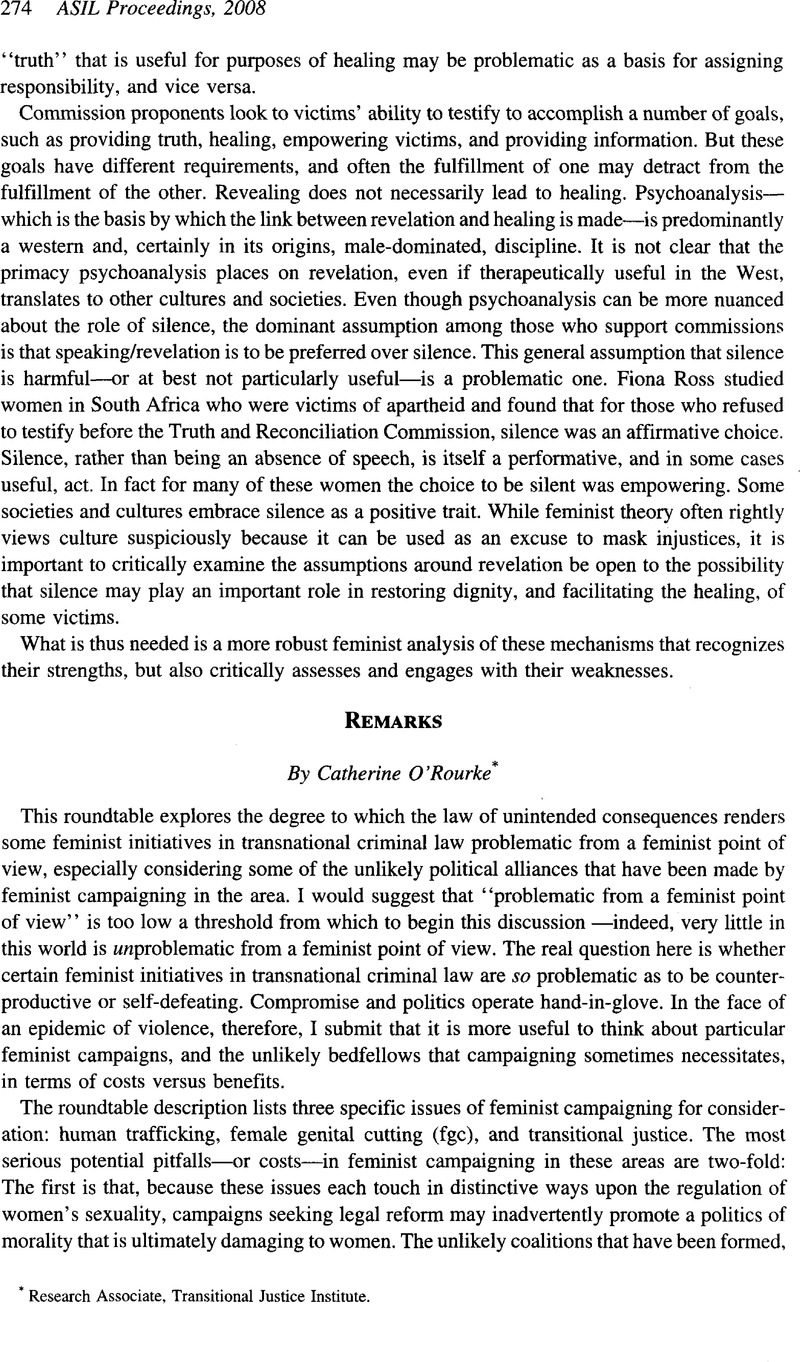No CrossRef data available.
Article contents
Remarks by Catherine O’Rourke
Published online by Cambridge University Press: 28 February 2017
Abstract

Information
- Type
- Feminism v. Feminism: What is a Feminist Approach to Transnational Criminal Law?
- Information
- Copyright
- Copyright © American Society of International Law 2008
References
1 See Spivak, Gayatri, Can the Subaltern Speak?, in Marxism and the Interpretation of Culture (Nelson, Cary & Grossberg, Lawrence eds., 1988)Google Scholar.
2 See, e.g., Fineman, Martha, Feminist Theory in Law: The Difference it Makes, Colum. J. Gender & L. (1992)Google Scholar; Fineman, Martha, The Neutered Mother, The Sexual Family, and Other Twentieth Century Tragedies (Routledge 1995)Google Scholar; Conaghan, J., Reassessing the Feminist Theoretical Project in Law, 27 J. L. Soc’y 351 (2000)CrossRefGoogle Scholar.
3 The dynamic of “running hard to stand still” succinctly captured in Smart, Carol, Feminism and Law: Some Problems of Analysis and Strategy, 14 Int’L J. Soc. L. 109, 109-123 (1986)Google Scholar.
4 Conaghan, supra note 2.
5 Hudson, Barbara, Restorative Justice and Gendered Violence: Diversion or Effective Justice?, 42 Brit. J. Criminology 616, 616-634 (2002)CrossRefGoogle Scholar; Hopkins, C.Q. & Koss, M.P., Incorporating Feminist Theory and Insights into a Restorative Justice Response to Sex Offenses, Violence Against Women, Spring 2005, 693-723 CrossRefGoogle ScholarPubMed.
6 See, e.g., Samuels, Harriet, Feminist Activism, Third Party Interventions and the Courts, Feminist Legal Stud. 15, 15-42 (2006)Google Scholar.
7 Lacey, Nicola, Unspeakable Subjects: Feminist Essays in Legal and Social Theory 97 (Hart Publishing 1998)Google Scholar.
8 Schneider, Elizabeth M, Battered Women and Feminist Lawmakers (Yale University Press 2000)Google Scholar.
9 Roth, Brad R., Governmental Illegitimacy in International Law (Oxford University Press, 2000)CrossRefGoogle Scholar.
10 Engle, Karen, Symposium: Comparative Vision of Global Public Order, Liberal Internationalism, Feminism, and the Suppression of Critique: Contemporary Approaches to Global Order in the United States, 46 Harv. Int’l L. J., 427 (2005)Google Scholar.
11 Sayeed, Almas, Making Political Hay of Sex and Slavery: Kansas Conservatism and the Global Regulation of Sexual Moralities, 83 Feminist Review, 119-131 (2006)CrossRefGoogle Scholar.
12 Symposium, Population Council ‘s Lessons Learnedfrom Over a Decade of Evaluating Approaches to Encourage Abandonment of Female Genital Mutilation/Cutting (FGM/C) (Feb. 6, 2008), available at <http://www.popcouncil.org/mediacenter/events/2008fgczerotoleranceagenda.html>.
13 See Obiora, L. Amede, Bridges and Barricades: Rethinking Polemics and Intransigence in the Campaign against Female Circumcision, 47 Case W. Res. L. Rev., 275, 275-378 (1997)Google Scholar; Gunning, Isabelle, Uneasy Alliances and Solid Sisterhood: A Response to Professor Obiora’s Bridges and Barricades, 47 Case W. Res. L. Rev., 445, 445-459 (1997)Google Scholar (for a more sympathetic account).
14 At, 24 I&N Dec. 296 (BIA 2007), Interim Decision #3584, September 27, 2007; and Ak, 24 I&N Dec. 275 (BIA 2007).
15 For an overview of these developments, see Bell, Christine & O’Rourke, Catherine, Does Feminism Need a Theory of Transitional Justice? An Introductory Essay, 1 Int’L J. Transit’L L., 23, 23-44 (2007)Google Scholar.
16 Chinkin, Christine, Rape and Sexual Abuse in International Law, 5 Eur. J. Int’l L., 3261, 326-341 (1994)Google Scholar.

